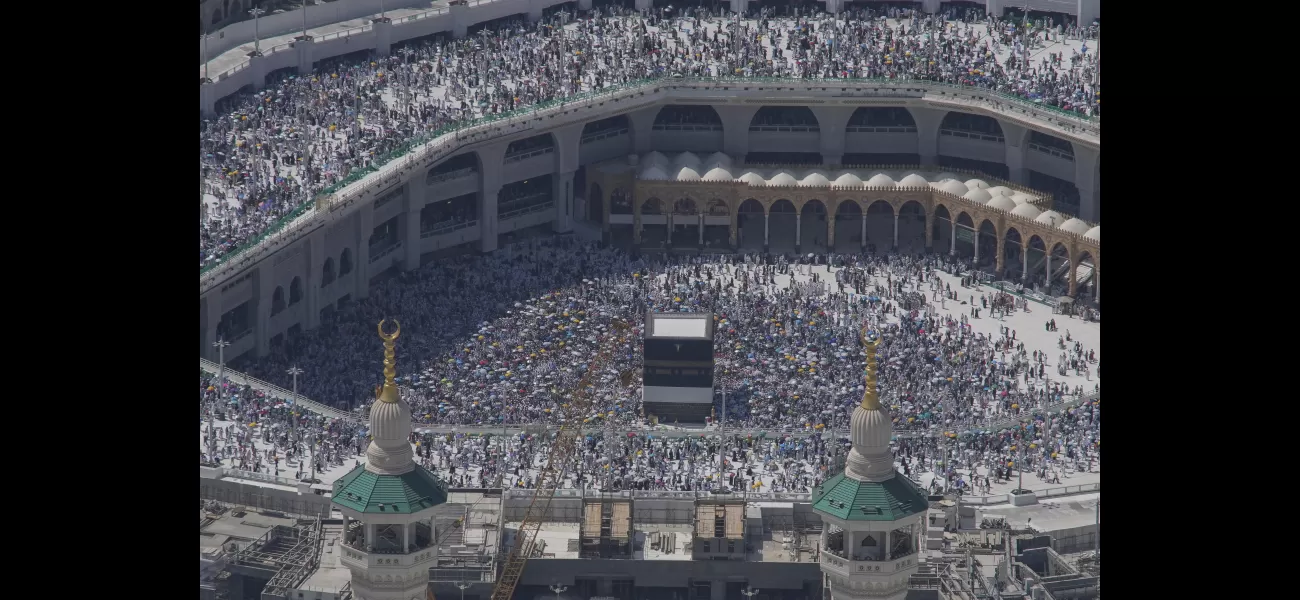Over 1300 people, including an Australian, have died during Hajj due to extreme heat.
Most of the fatalities in Saudi Arabia were unauthorized pilgrims who were unable to find shelter.
June 23rd 2024.

This year's Hajj pilgrimage in Saudi Arabia had a devastating outcome, as Saudi authorities revealed that over 1300 people lost their lives. The holy sites in the desert kingdom were hit with intense high temperatures, causing extreme conditions for the faithful who had traveled to Mecca. Fahd bin Abdurrahman Al-Jalajel, the Saudi Health Minister, shared that a staggering 83% of the fatalities were unauthorised pilgrims who had trekked long distances in sweltering heat to take part in the Hajj rituals.
In an interview with Al Ekhbariya TV, Minister Al-Jalajel disclosed that 95 pilgrims were currently receiving treatment in hospitals, with some being airlifted to the capital, Riyadh, for urgent care. One of the complications faced by the authorities was the difficulty in identifying the deceased, as many of them did not have any identification documents on them. The process had to be delayed until proper identification could be established.
Tragically, among those who lost their lives was a 46-year-old man from Sydney, who was thrilled to have been selected to be a part of this year's pilgrimage. The dead were laid to rest in Mecca, but no further details were provided by Al-Jalajel. The casualties included more than 660 Egyptians, with only 31 being authorised pilgrims. The Egyptian government has taken action against 16 travel agencies that had facilitated unauthorized pilgrims to Saudi Arabia.
According to sources in Cairo, most of the deceased were reported at the Emergency Complex in Mecca's Al-Muaisem neighborhood. Egypt had sent over 50,000 authorised pilgrims this year, but many others, mainly Egyptians, managed to reach the holy sites on foot. Unlike authorised pilgrims who had accommodation to escape the heat, these unauthorised pilgrims had no shelter to seek refuge in.
In a statement issued over the weekend, the Egyptian government declared that the 16 travel agencies had failed to provide adequate services to the pilgrims. These agencies had illegally used tourist visas instead of exclusive visas required for pilgrims. The government has taken strict action against these agencies, and their officials have been referred to the public prosecutor for further investigation.
According to the state-owned Al-Ahram daily, some travel agencies and Hajj trip organizers had even sold Saudi tourist visas to Egyptian pilgrims, disregarding the Saudi regulations. This left many pilgrims stranded in Mecca and the holy sites, enduring the scorching heat. The intense temperatures were believed to be the cause of death for many, as reported by countries like Jordan and Tunisia. AP journalists witnessed pilgrims fainting and collapsing due to the heat, with some even vomiting.
Unfortunately, deaths are not uncommon at the Hajj, which has seen over two million people travel to Saudi Arabia for this five-day pilgrimage. The history of the Hajj has been marked by deadly stampedes and epidemics, with this year's death toll being unusually high. In 2015, a stampede in Mina claimed the lives of over 2400 pilgrims, making it the deadliest incident in the history of the Hajj. However, the Saudi government has never disclosed the exact number of casualties. Another tragic incident that occurred the same year was the collapse of a crane at Mecca's Grand Mosque, killing 111 people.
The second-deadliest incident at the Hajj was a stampede in 1990, which claimed the lives of 1426 people. This year's high death toll suggests that there were exceptional circumstances at play. The temperatures during the Hajj period ranged between 46 and 49 degrees Celsius, making it extremely challenging for the pilgrims. The Saudi National Centre for Meteorology reported these high temperatures, with many pilgrims struggling to perform the symbolic stoning of the devil.
The Hajj is one of the five pillars of Islam and is considered one of the largest religious gatherings in the world. In 2024, over 1.83 million Muslims performed the Hajj, including 1.6 million from 22 different countries, and around 222,000 Saudi citizens and residents. The Saudi government has invested billions of dollars in crowd control and safety measures for the pilgrims, but the sheer number of participants makes it difficult to ensure their safety.
Moreover, with the threat of climate change looming, the risk could become even greater. A study conducted by experts from the Massachusetts Institute of Technology in 2019 revealed that even if the world manages to mitigate the adverse effects of climate change, the temperatures during the Hajj would still exceed an "extreme danger threshold" from 2047 to 2052 and from 2079 to 2086. As the Hajj follows a lunar calendar, it takes place 11 days earlier each year. By 2029, the pilgrimage will occur in April, and for several years after that, it will fall in the winter, with milder temperatures.
In today's fast-paced world, stay updated with all the latest news, celebrity gossip, and sports updates by following our WhatsApp channel. With no comments, algorithms, or privacy concerns, get all the latest information straight to your phone.
In an interview with Al Ekhbariya TV, Minister Al-Jalajel disclosed that 95 pilgrims were currently receiving treatment in hospitals, with some being airlifted to the capital, Riyadh, for urgent care. One of the complications faced by the authorities was the difficulty in identifying the deceased, as many of them did not have any identification documents on them. The process had to be delayed until proper identification could be established.
Tragically, among those who lost their lives was a 46-year-old man from Sydney, who was thrilled to have been selected to be a part of this year's pilgrimage. The dead were laid to rest in Mecca, but no further details were provided by Al-Jalajel. The casualties included more than 660 Egyptians, with only 31 being authorised pilgrims. The Egyptian government has taken action against 16 travel agencies that had facilitated unauthorized pilgrims to Saudi Arabia.
According to sources in Cairo, most of the deceased were reported at the Emergency Complex in Mecca's Al-Muaisem neighborhood. Egypt had sent over 50,000 authorised pilgrims this year, but many others, mainly Egyptians, managed to reach the holy sites on foot. Unlike authorised pilgrims who had accommodation to escape the heat, these unauthorised pilgrims had no shelter to seek refuge in.
In a statement issued over the weekend, the Egyptian government declared that the 16 travel agencies had failed to provide adequate services to the pilgrims. These agencies had illegally used tourist visas instead of exclusive visas required for pilgrims. The government has taken strict action against these agencies, and their officials have been referred to the public prosecutor for further investigation.
According to the state-owned Al-Ahram daily, some travel agencies and Hajj trip organizers had even sold Saudi tourist visas to Egyptian pilgrims, disregarding the Saudi regulations. This left many pilgrims stranded in Mecca and the holy sites, enduring the scorching heat. The intense temperatures were believed to be the cause of death for many, as reported by countries like Jordan and Tunisia. AP journalists witnessed pilgrims fainting and collapsing due to the heat, with some even vomiting.
Unfortunately, deaths are not uncommon at the Hajj, which has seen over two million people travel to Saudi Arabia for this five-day pilgrimage. The history of the Hajj has been marked by deadly stampedes and epidemics, with this year's death toll being unusually high. In 2015, a stampede in Mina claimed the lives of over 2400 pilgrims, making it the deadliest incident in the history of the Hajj. However, the Saudi government has never disclosed the exact number of casualties. Another tragic incident that occurred the same year was the collapse of a crane at Mecca's Grand Mosque, killing 111 people.
The second-deadliest incident at the Hajj was a stampede in 1990, which claimed the lives of 1426 people. This year's high death toll suggests that there were exceptional circumstances at play. The temperatures during the Hajj period ranged between 46 and 49 degrees Celsius, making it extremely challenging for the pilgrims. The Saudi National Centre for Meteorology reported these high temperatures, with many pilgrims struggling to perform the symbolic stoning of the devil.
The Hajj is one of the five pillars of Islam and is considered one of the largest religious gatherings in the world. In 2024, over 1.83 million Muslims performed the Hajj, including 1.6 million from 22 different countries, and around 222,000 Saudi citizens and residents. The Saudi government has invested billions of dollars in crowd control and safety measures for the pilgrims, but the sheer number of participants makes it difficult to ensure their safety.
Moreover, with the threat of climate change looming, the risk could become even greater. A study conducted by experts from the Massachusetts Institute of Technology in 2019 revealed that even if the world manages to mitigate the adverse effects of climate change, the temperatures during the Hajj would still exceed an "extreme danger threshold" from 2047 to 2052 and from 2079 to 2086. As the Hajj follows a lunar calendar, it takes place 11 days earlier each year. By 2029, the pilgrimage will occur in April, and for several years after that, it will fall in the winter, with milder temperatures.
In today's fast-paced world, stay updated with all the latest news, celebrity gossip, and sports updates by following our WhatsApp channel. With no comments, algorithms, or privacy concerns, get all the latest information straight to your phone.
[This article has been trending online recently and has been generated with AI. Your feed is customized.]
[Generative AI is experimental.]
0
0
Submit Comment





